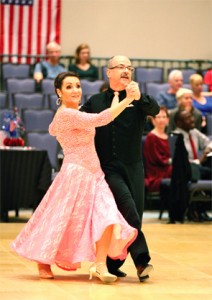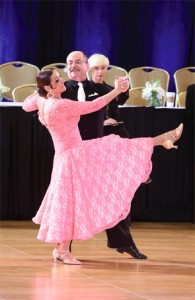
Dr. and Mrs. Miller dance the foxtrot at the October 2015 Chicago qualifier competition for the USA Dance National Championship.
Slow, slow, quick, quick.
Don Miller, PharmD, has repeated that phrase to himself countless times over the past 40 years. Since the 1980s, Dr. Miller, a professor of pharmacy practice in the College of Health Professions at North Dakota State University (NDSU), has been a competitive ballroom dancer.
Repeating that phrase is common to all ballroom dancers, along with counting steps and avoiding the cardinal sin of stepping on their partner’s toes. This may sound fairly complicated, but Dr. Miller, who was lured to the dance sport as a means for socializing and exercise, says he’ll dance as long as his legs will carry him.
Dr. Miller’s journey from the classroom to the ballroom began in 1976, after he received his Bachelor of Science in Pharmaceutical Science from the University of Manitoba in Winnipeg, Canada. Two years later, he received a Doctor of Pharmacy degree at the University of Michigan and then completed a one-year pharmacy residency at the University of Saskatchewan Hospital in Saskatoon, Saskatchewan, Canada. Then, in 1979, he accepted a teaching position at NDSU.
He became attracted to the field of rheumatology in the 1980s, when he worked closely with a rheumatologist, Justus Fiechtner, MD, on a number of drug studies, some sponsored by pharmaceuticals. Throughout his career, he also held other titles, such as an editorial board member for Arthritis Today, published by the Arthritis Foundation, and previously as a member of the ACR’s Drug Safety Subcommittee and Rheumatologic Care Committee, and now serves on the Food and Drug Administration’s Arthritis Advisory Committee.
Shortly after moving to Fargo, N.D., for his teaching position, he began searching for creative ways to meet people and “get out of the house,” says Dr. Miller.
“I had never done any dancing, had no musical ability,” he says. “I was pretty bad when I started.”
But he really enjoyed it, so he stuck with it. He says it took approximately a year of weekly dance lessons at a local dance studio before he could both hear and feel the beat of the music.
Competition Circuit

Dr. and Mrs. Miller dance the waltz at the February 2015 New York Dance Festival.
Dr. Miller made much progress during those early years, entering his first Pro/Am (professional/amateur) newcomer competition with his teacher in 1983. They performed several American Smooth dances, such as the tango, waltz, foxtrot and Viennese waltz, along with American Rhythm dances, which included the cha-cha, swing, bolero and mambo.


